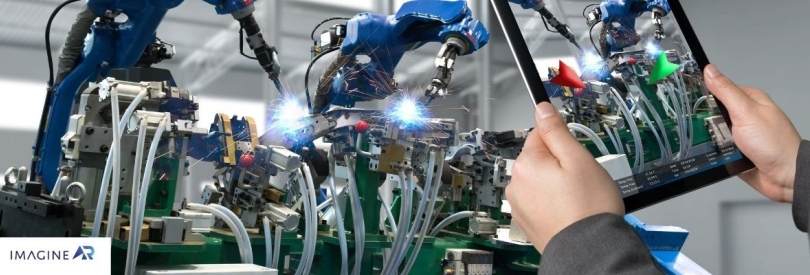
Equip Your Business With Augmented Reality To Gain An Edge
Data is the new oil and digital world, with three-dimensional information trapped on two-dimensional pages or screens. But unfortunately, the wealth of this data needs to be harnessed because it's not being applied in reality. Businesses can establish this connection with augmented reality and use rich content.
What if you could see the information or the rich data in the physical world to form that connection? Augmented reality helps your customers to interact with all the senses. This technology superimposes digital data and images in the physical world to provide an unparalleled experience. As a result, enterprises can adapt their business strategies to serve customers better and require changes in other areas like training employees, designing products, etc.
This post describes AR, its evolving technology and applications, and why it is crucial. Its significance will grow as it amplifies its power to create value and reshape competition. You will find the road map for how businesses can leverage augmented reality companies and consider the critical choices they face while integrating this technology into strategy and operations.
Key Capabilities Of AR
AR intensely heightens the value you can create by using capabilities. Remarkably, it enhances how users visualize & access monitoring data, receive & follow instructions and guidance on product operations, and control or interact with the products.
Visualization
AR applications offer a kind of X-ray vision that reveals internal features. For instance, AccuVein (medical device company), AR technology converts the patient’s veins heat signature into an image superimposed on the skin, making it easier for clinicians to locate veins. As a result, it dramatically enhances the success rate of drawing blood or any other vascular procedures.
A global provider of power units & controls, Bosch Rexroth, utilizes an AR-enhanced visualization to exhibit the capabilities and design of its smart & connected CytroPac hydraulic power unit. The AR enables consumers to see 3-D representations of the unit’s internal pump & cooling operations in multiple configurations, and all the subsystems fit together.
Guidance & Instruction
AR is redefining training, instruction, and coaching. These critical functions enhance workforce productivity, which is expensive & labor-intensive and usually delivers inconsistent results. For example, the written instructions for assembly are the most complex and time-consuming to follow. Even the standard videos aren't that interactive to help with the learning needs of individuals. But in-person training is costly and requires all participants to be located at the same place. That's not convenient at all!
AR handles all these issues to provide real-time, step-by-step, and on-site visual guidance on tasks like machine operation, warehouse picking, and product assembly. It's an interactive 3-D hologram guide that walks the user through the essential processes. As a result, little is left to the imagination or interpretation.
AR Creates Value
The way AR creates business value is many and varied. It can be found at the core of products themselves and improving performance across all areas such as product development, marketing, service, manufacturing, etc.
Product Features
The AR capabilities play a growing role in the design, creating interactive user interfaces and ergonomics. For instance, how products convey necessary safety information and operational information to users has increasingly become a point of differentiation. Dedicated AR heads-up displays are added to automobiles and are vital in fighter jets or elite military products. Unfortunately, it is too expensive and bulky to integrate, but smart glasses are a breakthrough with wide-ranging uses for all manufacturers.
You can use the smart glasses to see the oven's virtual display showing the remaining minutes on the timer, baking temperature, and recipe. Similarly, when you view the car, the AR display shows if the vehicle is locked or not, the level of fuel in the tank, tire pressure, etc. The AR user interface can continually evolve with personalization as it's purely software-based and delivered through the cloud. The manufacturers can benefit from it as its incremental interface cost is low with disruptive impact and competitive positioning.
Product Development
AR enables 3-D models superimposed on the physical world as holograms, enhancing, improving, and evaluating the designs. For instance, a life-size 3-D hologram of a construction machine can be positioned on the ground. You can thoroughly inspect it to appreciate the sightlines and ergonomics design.
AR superimposes CAD models on physical prototypes to compare how they match. Volkswagen uses the same method, distinguishing between the prototype and the latest design visually apparent to check alignment. As a result, it enhances the accuracy of the quality assurance process, making the process 10 times faster. Moreover, it increasingly informs product design by revealing where, when, and how users interact with the product. In this way, the AR interface will become an essential data source.
Sales & Marketing
AR redefines the concept of showrooms & product demonstrations and transforms the customer experience. So, the customers can virtually see the products and their functions before buying them. This allows consumers to have more-accurate expectations with their purchase decisions and product satisfaction. As a result, AR will reduce the need for physical stores and showrooms altogether.
When products are configured with different features and options, making it challenging and expensive to stock, AR is an invaluable marketing tool. For example, AZEK (construction products company) uses AR to display to contractors and consumers how its decking and paver products look in various colors and arrangements. The experience lessens customers' uncertainty of choices and curtails the sales cycle. Similarly, AR applications allow online shoppers to download holograms of products in e-commerce. For instance, Wayfair & IKEA offers thousands of 3-D product images and apps libraries to integrate them in an actual room, helping customers see furniture and decor in real-time.
Conclusion
AR is used in a business setting to create value for the company in many ways. These key capabilities include visualization, guidance and instruction, and increased sales and marketing.
By understanding what features are most valuable to your customer base, you can begin developing products with AR and increase sales via marketing efforts that speak to the unique benefits of augmented reality. With the right tools in place, your business can leap ahead of the competition by leveraging augmented reality companies to provide an immersive experience that will keep customers coming back for more.
ImagineAR will be happy to help you get started on this exciting new technology that will revolutionize the way we do business. So connect with us today if you're looking to equip your business with augmented reality.







